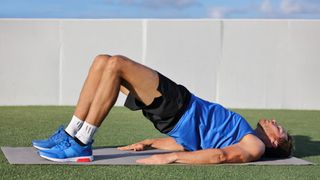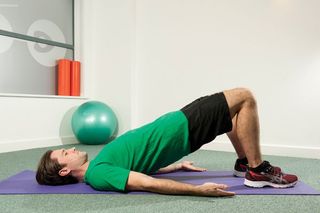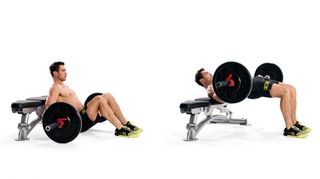How To Do The Glute Bridge
The simple route to a perfect posterior – here’s how to master the glute bridge

There are three gluteal muscles – the maximus, medius and minimus – father to a murdered son, husband to a murdered wife, and so on. They’re important in hip flexibility and movement, as well as looking fabulous.
Spending all day sitting behind a desk is a surefire shortcut to weak glutes and lower back problems. The impulse is often to sit too far forward, which causes your hip flexors to become tight and also results in the glutes effectively switching off. Activating them as part of your training programme does wonders not only for your physique but for your structural health.
How To Do The Glute Bridge

- Lie face up on the floor, with your knees bent and feet flat on the ground. Keep your arms at your side with your palms down.
- Lift your hips off the ground until your knees, hips and shoulders form a straight line. Squeeze those glutes hard and keep your abs drawn in so you don’t overextend your back during the exercise.
- Hold your bridged position for a couple of seconds before easing back down.
Aim for two sets of ten bridges, two to three times a week, either as part of a wider bodyweight workout or on their own, if all you really care about is your derrière.
Benefits Of The Glute Bridge
You should feel the burn in your glutes and your hamstrings if you’re doing it correctly. The bridge is also great for improving hip mobility and strengthening your lower back, two things that any desk-bound worker can really benefit from.
Glute Bridge Variations
Single-Leg Glute Bridge

There are plenty of worthwhile variations to the glute bridge that don’t require any gym equipment. The best place to start is with the single-leg glute bridge, which halves the number of grounded legs to double the difficulty.
Lie on your back and bend your knees so your feet rest flat on the floor. Then raise one leg until it is stretched out straight. Brace yourself, then drive the heel of the foot still grounded into the floor and push your hips up until your body is in a straight line from your shoulders to the toes of your outstretched foot. Slowly lower yourself again, then repeat on the same side. Aim for ten reps on one leg, then switch to the other.
Medicine Ball Glute Bridge

This is best performed on a gym mat. Elevate your feet by placing them both on a medicine ball and, keeping your core engaged, drive through your heels until you’re extended. Pause for a second or two and squeeze your glutes. Slowly lower back to the start, but don’t let your glutes touch the floor because this would take the tension off the target muscles.
Get the Coach Newsletter
Sign up for workout ideas, training advice, reviews of the latest gear and more.
Glute Bridge And Curl
You can also ramp up the challenge of the glute bridge by adding a towel into the mix. Put your feet on it and slide them out and back in slowly when in the bridged position, keeping your hips raised throughout. This is called the glute bridge and curl, and it’s tough.
Glute Bridge March
Another tough variation is the glute bridge march. Once you’re in the elevated position of a regular glute bridge, move one leg slowly up towards your chest in a high-knee “marching” motion. Then lower it and march with the other leg. Alternate until you reach a total of 40 marches, 20 on each side.
Hip Thrust

Once you feel you have sufficiently mastered the bodyweight glute bridge, step up to what is essentially a barbell glute bridge. You’ll need to find yourself a flat bench, and lie horizontally on it supported by your upper back. Select a weight that allows you to perform six to eight reps with good form. Position the centre of the bar at your midriff level, with a squat pad or a towel between you and it. Slowly lower, and then initiate the pressing phase by driving through your heels. Extend vertically at the hips at the top portion of the lift.

Nick Harris-Fry is a journalist who has been covering health and fitness since 2015. Nick is an avid runner, covering 70-110km a week, which gives him ample opportunity to test a wide range of running shoes and running gear. He is also the chief tester for fitness trackers and running watches, treadmills and exercise bikes, and workout headphones.
